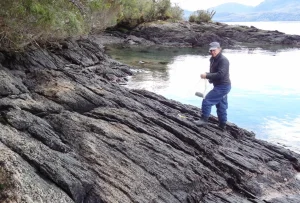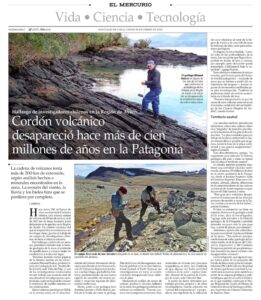El Mercurio| UNAB Geology Academics Discover a Lost Volcanic Chain of the Lower Cretaceous
UNAB Geology researchers from the Viña del Mar campus have discovered a volcanic chain that disappeared more than 100 million years ago in Patagonia.
UNAB Geology academics Manuel Suárez (UNAB Merit Award in Science 2022), Jean Baptiste Gressier, Pablo Rossel, and SERNAGEOMIN geologist Rita de la Cruz published a scientific article reporting the existence of a volcanic chain that disappeared more than 100 million years ago due to erosion over time, including the effects of rains, winds, and ice.
«Our study discovered the presence of a chain of volcanoes from the Lower Cretaceous period (135 to 123 million years ago) in Chilean Patagonia (Aysén Region), 50 km wide and more than 200 km long,» said Jean Baptiste Gressier, director of Geology at the UNAB Viña Mar campus.
Note from El Mercurio:
Discovery by Chilean Researchers in the Aysén Region
The volcanic range disappeared more than 100 million years ago in Patagonia.
According to the analysis of minerals found in the area, the chain of volcanoes was more than 200 km long. Erosion by wind, rain, and ice caused it to be completely lost.
Around 130 million years ago, in the Lower Cretaceous period, an extensive chain of volcanoes, 50 km wide and more than 200 km long, formed part of the landscape in what is now the Aysén Region. The volcanic chain’s existence was suspected, and now, thanks to the work of a team of Chilean researchers, there is concrete evidence.
 This finding, according to its authors, will allow for a better understanding of the geological history of the area, the environment of that time, and a better knowledge of the current conditions of the site.
This finding, according to its authors, will allow for a better understanding of the geological history of the area, the environment of that time, and a better knowledge of the current conditions of the site.
«We are reading certain pages of history written in the rocks,» commented Manuel Suárez, full professor of Geology at the U. Andrés Bello (UNAB), Viña del Mar, and one of the researchers involved in this work that has taken more than a decade of research. From this, it has been possible to learn about the existence of marine reptiles such as plesiosaurs.
 Suarez also participated in the discovery of the first Jurassic dinosaur found in the national territory in the same area in 2004: Chilesaurus diegosuarezi (in honor of his son Diego, who found the fossils) and, later, of a new species of crocodile from the same period and three other species of herbivorous dinosaurs.
Suarez also participated in the discovery of the first Jurassic dinosaur found in the national territory in the same area in 2004: Chilesaurus diegosuarezi (in honor of his son Diego, who found the fossils) and, later, of a new species of crocodile from the same period and three other species of herbivorous dinosaurs.
Now, together with geologists Jean Baptiste Gressier and Pablo Rossel, both from UNAB, as well as geologist Rita de la Cruz, from SERNAGEOMIN, they have just published their research on the volcanic chain that disappeared millions of years ago in the International Journal of Earth Sciences.
By analyzing the remains of ashes, stones, and zircons found in the area, geologists were able to establish its existence. «There were four or five field campaigns. These minerals are formed by magmatic processes, that is, they are evidence that there was once volcanic activity in the area,» explains Gressier, director of the Geology program at UNAB’s Viña del Mar campus.
From data obtained from previous works, their own and from other researchers, they put together the «pieces of the puzzle» and proposed this hypothesis of the location of the volcanic arc: west of the Aysén Region and with a lifespan of about 10 million years, short by geological standards.
«When magma rises from the depths of the earth, a part of it reaches the surface in the form of lava and ashes, while another part remains accumulated kilometers below the surface,» adds Suárez.
This study analyzed larger crystals or minerals, which are part of the so-called Patagonian batholith -a group of rocks formed by the cooling of magma- and remains of ash accumulated on the seabed.
«Our interpretation is that the roots of these volcanoes were in the western end of the Chonos archipelago (Aysén Region),» says Suárez.
The study also revealed how this volcanic chain migrated in position, due to the effect of the tectonics of the subduction plates. «The oceanic plate passes underneath the continental plate; the higher temperature and pressure that is generated melts the base of the continental plate and that generates magmatism,» Gressier explains.
This discovery is crucial to understanding the geological history of the southern territory and how it was formed over the years.
The study also suggests continuous volcanic activity of at least 90 million years in western central Patagonia, from the Upper Jurassic to the Upper Cretaceous, indicating differences in the behavior of the volcanic chains in Aysén concerning those in central and northern Chile.
«This great volcanic arc disappeared over the years due to erosion processes caused by rain, winds, and the action of ice,» says Gressier.
Although its existence does not directly impact the current geology of the area, this study provides additional information to understand the geological history of Patagonia and to reconstruct the paleoenvironment of the time.
The ongoing research is part of a project of the Innovation Fund for Competitiveness (FIC) of the Regional Government of Aysén, which seeks to contribute to turning this area into a scientific center based on its geological and paleontological richness, carried out by UNAB and in which the Regional Museum of Aysén, the Museum of Natural History of Santiago, and the Argentine Museum of Natural Sciences of Buenos Aires are also collaborating.
 English version
English version 

